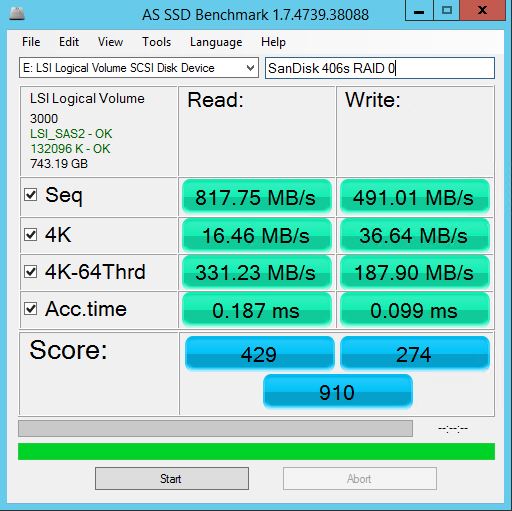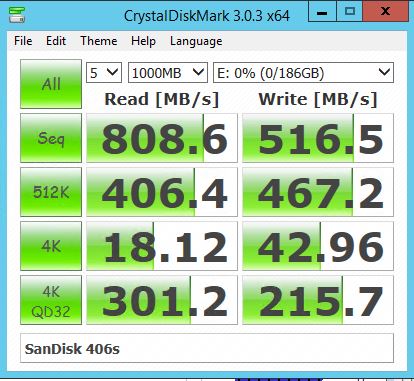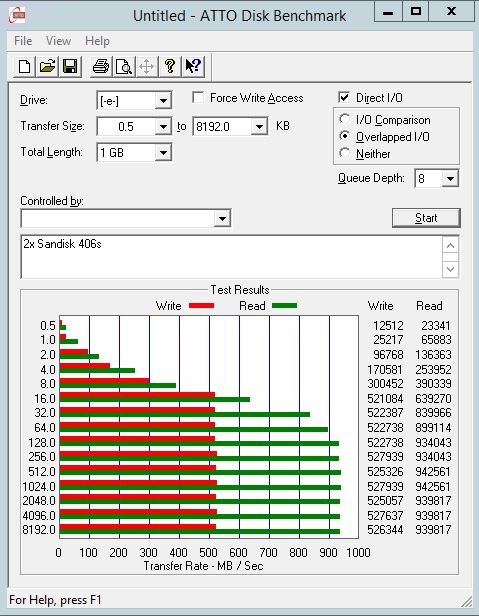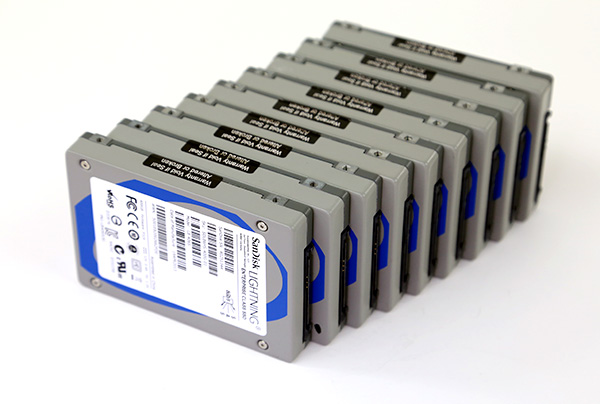The final stop for our initial four drives in the SSD roundup is quick RAID 0 benchmarks of our SanDisk Lightning 406s 400GB SSDs (SLC.) This is the eighth part of our quick and dirty benchmarking series with SAS SSDs we have acquired for prices between $0.55- $0.60/ GB. Next up for the round-up will likely be a few baseline results with 12gbps SAS rotating disks and new NVMe products which are alternatives in the enterprise space. Still, the drives we have were purchased at close to consumer drive prices so they are certainly more affordable. Thus far, we have seen in our “quick and dirty” testing to date is that some of the SAS SSDs are performing better than expected in RAID 0 arrays where data is striped across two drives instead of one. The hypothesis is that most SAS SSDs are intended for enterprise RAID arrays so they may be optimized for RAID workloads. We have certainly seen some cases where this hypothesis was supported and not supported. Today we are going to take a look at the 400GB SLC Lightning to see how it compares. SanDisk does have a MLC version of the drive also.
We are continually growing this data set but here are the benchmark runs thus far:
Single SAS SSD Benchmarks
- Pliant/ SanDisk Lightning 206s 200GB SLC SAS SSD benchmarks
- Seagate Pulsar.2 200GB MLC SAS SSD benchmarks
- Pliant/ SanDisk Lightning 406s 400GB SLC SAS SSD benchmarks
- Smart Storage System/ SanDisk Optimus 400GB MLC SAS SSD benchmarks
2 Drive RAID 0 Benchmarks
- 2x SanDisk Lightning 206s 200GB SAS SSD benchmarks
- 2x Seagate Pulsar.2 200GB SAS SSD benchmarks
- 2x Smart Storage System/ SanDisk Optimus 400GB MLC SAS SSD benchmarks
Our goal is to continue posting one more per week in-between other articles. We are also working on being able to add NVMe based SSDs to this as a comparison to state-of-the-art NAND storage. More on that shortly.
Test Configuration
Since we are going to assume the use of already released hardware, we are using a legacy system for testing across the test suite:
- Motherboard: Gigabyte GA-7PESH3
- Processors: Dual Intel Xeon E5-2690 (V2)
- SAS Controller: (onboard LSI SAS2008 in IR mode)
- RAM: 64GB DDR3L-1600MHz ECC RDIMMs
- OS SSD: Kingston V300 240GB
We did not use our Intel Xeon E5-2600 V3 platforms because this series started prior to the embargo being lifted on that platform. The Gigabyte’s LSI controller found onboard is the same as can be found in countless platforms and cards such as the IBM ServeRAID M1015 and LSI 9211-8i. We decided to use this controller since it is an extremely popular first-generation 6gbps SAS II controller. For those looking to build value SAS SSD enabled arrays, the LSI SAS2008 is likely going to be the go-to controller. A major point here is that we are using a SAS controller. This means that one cannot compare results directly to consumer-driven setups where a SATA SSD is connected to an Intel PCH port. There is a latency penalty for going over the PCIe bus to a controller to SAS. It also is a reason NVMe is going to be a game changer in the enterprise storage space.
Controller wise, the LSI SAS 2008 controller has plenty of headroom for this configuration. We have been testing a new platform for both 2.5″ NVMe drives and using newer Intel Xeon E5-2600 V3 processors. That form factor requires a different physical infrastructure so it is going to be a bit different. More to come on the test beds soon.
SanDisk Lightning 406s 400GB SSD RAID 0 Quick Benchmarks
For our quick tests during this part of the series we will just provide the quick benchmarks with only a bit of commentary. The results should be fairly straightforward and the index of previous articles in this series (linked above) is a good resource to compare against.
AS SSD Benchmark
AS SSD is a solid benchmark that does not write compressible data to drives. The result is perhaps one of the best workstation SSD benchmarks available today.

Here we see almost exactly a 2x sequential read speed scaling and slightly more than 2x write speed scaling. That is exceptional. The 4K numbers were very similar to what we saw with the single 400GB drive.
CrystalDiskMark
CrystalDiskMark is another benchmark which gives non-compressible read/write numbers. This is in contrast to the ATTO Benchmark used by LSI/ Sandforce and its partners when they market a given solid state drive.

Sequential write speeds again are the story here. They are more than 25% faster than we saw with the Pliant/ SanDisk LB206s 200GB SAS SSDs in RAID 0. The single drive configuration was completely obliterated by CrystalDiskMark but the RAID 0 configuration handled it well.
ATTO Benchmark
The value of the ATTO benchmark is really to show the best-case scenario. ATTO is known to write highly compressible data to drives, which inflates speeds of controllers that compress data like LSI/ SandForce does prior to writing on a given solid state drive.

ATTO mostly tests sequential speeds and works well with compression. Here we see results of around 940MB/s read and 520MB/s write which is certainly a strong result. For many workloads, this is completely acceptable performance and the performance remains very flat across transfer sizes. The SanDisk Optimus and Seagate Pulsar.2 drives both had pronounced curves ones the transfer size got larger. Write speeds are virtually flat from 16-8192 which is outstanding.
Conclusion
Overall, performance in RAID 0 mode was great for the SanDisk Lightning 400GB SAS drives. The SLC NAND may not be the fastest to write too, but the drives to perform fairly well in our testing. Given the enormous write endurance of the 34nm SLC NAND on these drives, they seem to be solid workhorse drives for datacenter applications. It is little wonder why HP, Dell, NetApp and others all used these drives in their high-end storage arrays.




